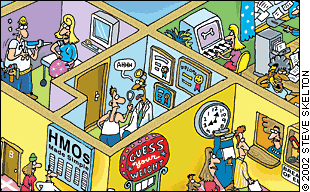
Fam Pract Manag. 2002;9(7):12

The practice shown on our cover has enough problems that you might need a key to identify them. Especially since none of the major problems show in the picture.
Forget the woman talking on the banana
What’s really wrong with the practice? For starters, the physicians all handwrite their prescriptions. They miscode visits regularly – mostly on the low side, too. They have patients who miss appointments, leaving holes in the schedule. More than that, they have patients who miss diabetes follow-up appointments, but they’re not sure how many or who they are. Their patients on warfarin have INRs that bounce around like Superballs. Occasionally they blow a diagnosis. They have no way of knowing that the report from a patient’s recent mammogram fell behind a desk before her doctor saw it. Last month, a doctor and three staff members spent 20 minutes looking for a misplaced chart. There is more, but even with this short list of problems, you can see that having a family of ducks in the waiting room is small potatoes. At least those ducks are in a row.
I don’t believe the troubles I have attributed to this poor practice are terribly unusual. In fact, you may see your practice in the paragraph above, if not in the picture. Some of the problems may even be so common that you hardly think about them: Of course patients miss appointments. That’s a part of life … isn’t it?
There are ways of fixing, or at least ameliorating, every problem I mentioned. Some are touched on in this special-focus issue. The bad news is that fixing problems like this requires creativity and energy. The good news is twofold, though. First, fixing these problems can pay you back – in direct financial benefit, in time saved or in a net reduction of your stress level. And second, the answer is not “Try harder.”
Not even you can try hard enough
Chances are good that few of the errors that occur in your practice are due to incompetence, laziness or ignorance, either on your part or on the part of your staff. Rather, they occur because you and your staff (and your patients) are human, and human beings make mistakes. And when errors have undesirable consequences, chances are it’s because your practice isn’t designed with human beings in mind. That may sound strange, but it’s both true and important.
Given that human error is inevitable, you need non-human systems in place to prevent as many errors as possible and to prevent the consequences of those that occur. No one can do it all. Not even you. If you get a drug dosage wrong, it’s not because you are inadequate as a physician. More likely, it’s because you are expecting yourself to remember one more thing than is humanly possible – and because you don’t have a convenient reminder of the correct dosage at your fingertips or an electronic prescribing system that would query your choice of dosage as you make it.
You aren’t perfect and shouldn’t expect yourself to be. But that doesn’t mean you can’t move your practice toward perfection. Build in procedures, reminders, references, systems. Consider the following “nominal human error rates”:
Error of omission without reminders: 0.01
Error of omission when item is embedded in a procedure: 0.0031
One error in 100 efforts may be decent performance or it may not, depending on the importance of what is omitted. But it doesn’t sound so good compared to three in 1,000. That’s the challenge facing you now. The articles in this issue can’t do more than suggest some directions to go. But clearly the direction is important. Why not systematize things and improve by an order of magnitude?